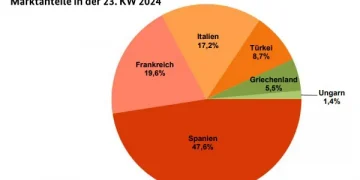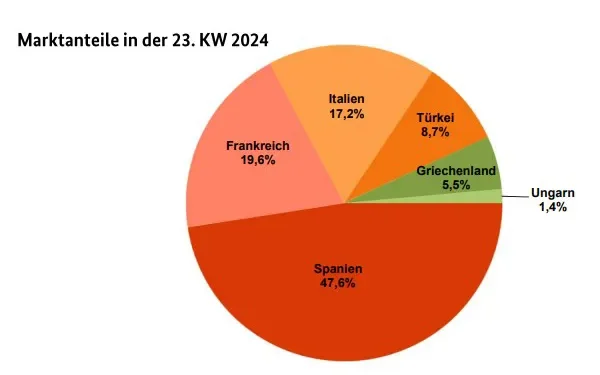Analysis of Market Dynamics and Emerging Trends Across Popular Fruits
In the bustling European fruit markets, Spanish apricots maintained a dominant presence, though not without critique regarding their organoleptic qualities, according to the BLE (German Federal Agency for Agriculture and Food). French and Italian apricots followed at a distance, while Turkish Matador apricots made occasional appearances, albeit not universally across markets. Notably, Turkish Sekerpare apricots were exclusively observed in Munich, while Greek apricots complemented offerings in Frankfurt. Hungarian imports, processed in Austria, earned praise for their taste in Munich, contrasting with occasional quality concerns about Spanish and French batches.
The market observed an overall increase in apricot availability, leading to frequent discounts, particularly noticeable for smaller calibers that struggled to maintain price stability.
Apples: The European apple assortment continued to contract, with growing contributions from overseas sources such as New Zealand, Chile, and South Africa, expanding supply options.
Pears: Market conditions for pears remained stable, with balanced supply and demand scenarios minimizing price adjustments.
Grapes: Italian varieties like Black Magic and Victoria gained prominence, supported by increased Egyptian shipments featuring Flame Seedless and Prime Seedless grapes.
Strawberries: Domestic strawberries dominated the market, resulting in expanded availability and periodic price declines due to fluctuating demand.
Cherries: Spanish cherries led the market, with notable contributions from Turkish, Greek, German, Italian, French, and Belgian sources diversifying offerings.
Peaches/Nectarines: Overall shipments increased despite tepid consumer interest due to cooler weather, prompting periodic price reductions by traders.
Lemons: Spanish Verna lemons remained dominant despite increased arrivals of South African Eureka lemons, maintaining stable ratings.
Bananas: A balanced market saw stable prices, reflecting sufficient supply relative to demand.
Cauliflower: Domestic cauliflower prevailed, supplemented by Belgian and Polish imports, with occasional arrivals from Turkey.
Lettuce: Head lettuce predominantly featured domestic varieties, with minor Belgian and Dutch offerings, while Spanish ice lettuce also made appearances.
Cucumbers: A varied assortment included domestic, Dutch, and Belgian cucumbers, meeting demand without significant price fluctuations.
Tomatoes: Belgian and Dutch tomatoes formed the core of supply, with increasing availability and consistently high quality meeting friendly market demand.
Bell Peppers: Sufficient availability was managed effectively, though prices occasionally saw upward trends early in the week.
Asparagus: As the season drew to a close, domestic deliveries of white, purple, and green asparagus declined, marking the conclusion of a robust campaign.































